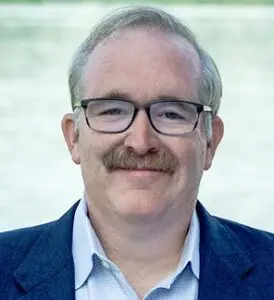David Goldberg, who lives in Philipstown, is a lawyer and constitutional scholar. He will discuss the U.S. Supreme Court and the presidency on Jan. 12 at the Desmond-Fish Public Library in Garrison.
Why did you want to be a civil rights lawyer?
Before becoming the first Black Supreme Court Justice, Thurgood Marshall was my ideal of a lawyer — fighting for civil rights in the segregated South, arguing in front of white racist judges and yet keeping his sense of humor. Like Marshall, I wanted to right the great wrongs of our country and do it through litigation.
Tell us about one of your first civil rights cases.
After clerking for Justice David Souter, I went to work for the NAACP Legal Defense Fund, which was founded by Marshall. [Goldberg also clerked for Ruth Bader Ginsberg before she joined the court.] One of my first cases took place in the 1990s when there was a panic about “crack babies.” South Carolina was prosecuting a woman for murder on the theory that the drugs she took killed her fetus. It was an abuse of governmental power against a very vulnerable person. She had tried to get help and been turned away. There were elements of racial and gender discrimination. The South Carolina courts heard testimony from our expert obstetrician, who said the cause of death had not been the drugs. The conviction was vacated.
You’ve participated in over 150 cases before the Supreme Court. What is the difference between the life of an appellate lawyer and a trial lawyer?
I’ve never had a taste for the combat of trial litigation. I’m a nerd, and I don’t like yelling at people. For an appellate lawyer, harsh combat is writing a sarcastic footnote. Most appellate work is writing long briefs. You’re sitting alone in an office and thinking and reading and trying to draft arguments. To win, you count votes, try to identify swing justices and craft arguments to persuade those justices. Then you find people to write amicus briefs that support your points. I’ve only made one oral argument before the Supreme Court [in 2017].
Any interesting stories from the Supreme Court?
I was involved in a case in which I helped write the brief. I was sitting at counsel’s table during oral arguments. The lawyer making our argument didn’t do particularly well. Later that day, I ran into Justice Ginsberg. She said, “You looked like you were in agony up there.” It reminded me that the Supreme Court courtroom is an intimate place. The justices are only 8 feet away. They can read your face. I learned that no matter how badly things are going, I have to keep smiling and looking like we’re kicking ass.
Has your career differed from what you expected?
I envisioned marching down the field to make a more just and fair society. But a lot of my work has involved keeping the court from rolling back progress. For a progressive-minded attorney, it’s like Charlie Brown repeatedly trying to kick the football only to have Lucy pull it away at the last second. That’s why I’ve started focusing on state constitutions. State supreme courts are open for business and receptive to cases the U.S. Supreme Court is less interested in. That includes juvenile sentencing, gerrymandering and environmental protections. Rather than banging my head against the wall at the U.S. Supreme Court, I’m finding new places to fight the fight.


